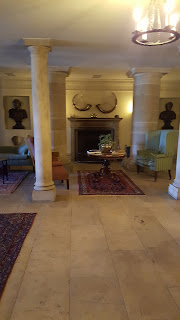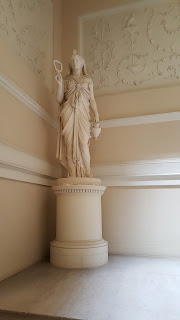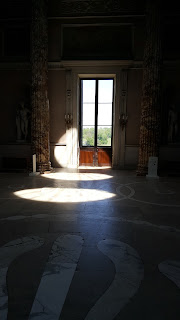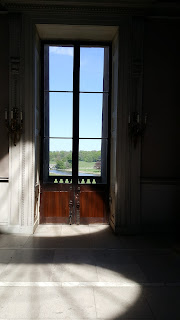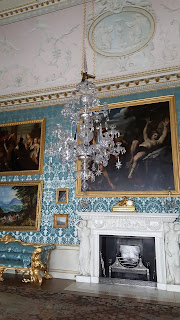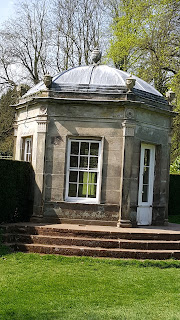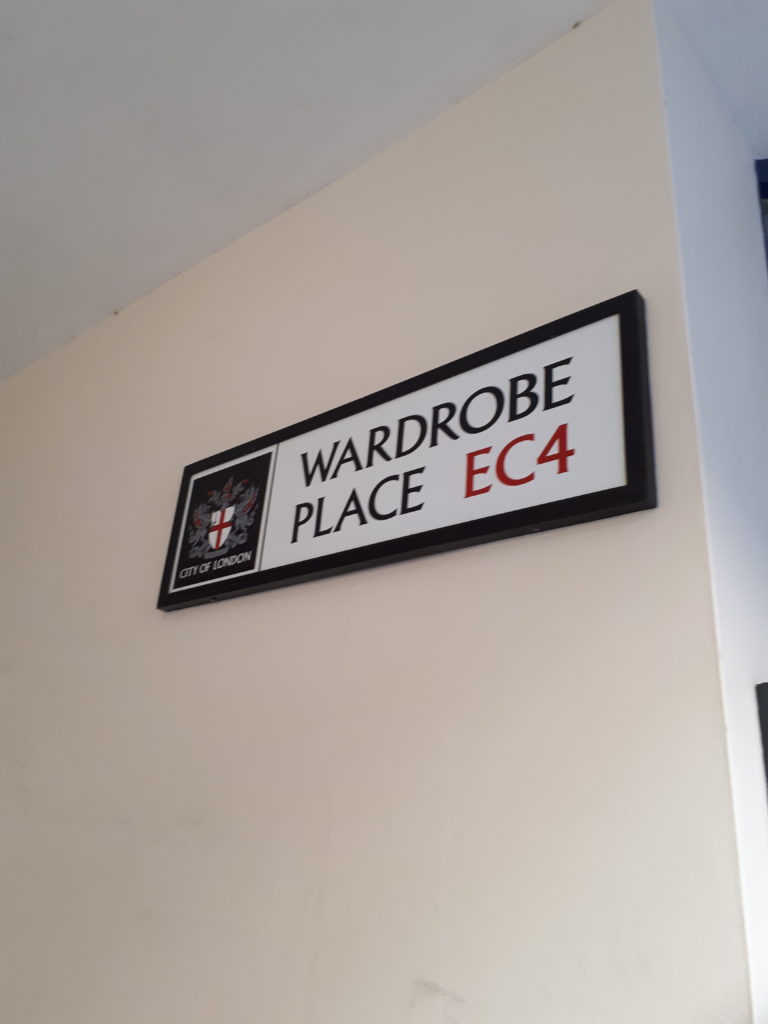Originally published in June 2016
I had bought this large (800+ pp) volume at Hatchard’s on my trip to London in 2014 and had first tried to read it when it finally arrived in a Royal Mail bag, along with several other books I’d purchased. I made it through the first chapter before realizing that I was thoroughly lost – who in the world is Honks? Which sister was called Woman? And who is The French Lady, as there were two sisters who lived in France? At that time, I had scant knowledge of the biographies and inner workings of the Mitford Sisters. Thus, I’ve spent the past year attempting to rectify that deficit, not simply in order to be able to read this book, but because the Mitford sisters, their circle of family and friends, the times they lived through and much else about them is fascinating.
 |
| The Mitford sisters (clockwise from top left): Unity; Jessica; Diana; Nancy; Deborah; Pamela |
Below are the thumbnail biographies for each sister, and their brother, from the Mitford Family entry in Wikipedia:
- Nancy Mitford (28 November 1904 – 30 June 1973). Married Peter Rodd and had a longstanding relationship with French politician and statesman Gaston Palewski. She lived in France much of her adult life. A writer of many novels, including her most popular (and somewhat autobiographical), The Pursuit of Love and Love in a Cold Climate. Also a noted biographer of historical figures, including the Sun King.
- Pamela Mitford (25 November 1907 – 12 April 1994). Known as “Woman.” Married and divorced the millionaire physicist Derek Jackson. John Betjeman, who for a time was in love with her, referred to her as the “Rural Mitford”. After her divorce, she spent the remainder of her life as the companion of Giuditta Tommasi (died 1993), an Italian horsewoman.
- Thomas Mitford (2 January 1909 – 30 March 1945), known as Tom was educated at Eton, a close friend of James Lees-Milne there. Lover of Tilly Losch during her marriage to Edward James. Died as a soldier in Burma. According to Jessica’s letters, he supported British fascism and was stationed in Burma after refusing to fight in Europe.
- Diana Mitford (17 June 1910 – 11 August 2003). Married aristocrat and writer Bryan Walter Guinness in the 1929 society wedding of the year. She left him in the society scandal of the year (1933) for British fascist leader Sir Oswald Mosley. She was interned in Holloway Prison during the Second World War. Her belief in fascism never wavered nor her affection for Adolf Hitler. Mother of Max Mosley.
- Unity Valkyrie Mitford (8 August 1914 – 28 May 1948), “Bobo” or “Boud” to her siblings. Famous for her adulation of and friendship with Adolf Hitler. Shot herself in the head days after Britain declared war on Germany, but failed to kill herself and eventually died of pneumococcal meningitis at West Highland Cottage Hospital, Oban, after being transferred from Inch Kenneth.
- Jessica Mitford (11 September 1917 – 22 July 1996), commonly known as “Decca”. Eloped with Esmond Romilly to the Spanish Civil War. Spent most of her adult life in the United States. Two years after Esmond was killed during the Second World War she married Robert Treuhaft, whom she met as a fellow US government employee. Member of the American Communist Party until 1958. She wrote several volumes of memoirs and several volumes of polemical investigation, including the best-sellingThe American Way of Death (1963) about the funeral industry. Grandmother of James Forman, Jr. and Chaka Forman, sons of the African-American civil rights leaderJames Forman by her daughter Constancia Romilly.
- Deborah Mitford (31 March 1920 – 24 September 2014). Married Andrew Cavendish who became the Duke of Devonshire, and with him turned his ancestral home,Chatsworth House, into one of Britain’s most successful stately homes. She wrote a dozen books.
To read more on the Sisters, click here to find a 2014 article on them from the BBC Magazine. I won’t give you my personal opinion on each sister, as I don’t want you to be influenced before you read the book yourself.
Letters Between Six Sisters was edited by Charlotte Mosley, who is married to Max Mosley, son of Diana Mitford. She has done a marvelous job here and managed to organize a monumental amount of material into a cohesive and very readable format. As the Editor’s Note tells us from the start, “the correspondence between the six Mitford sisters consists of some twelve thousand letters – of which little more than five per cent has been included in this volume.” The letters begin in 1925 with a single letter from Pamela to Diana and pick up speed in the early 1930’s. Mosley thankfully prefaces each decade with an overview of what was occurring in the lives of each sister during that time. Naturally, the elephant in the room for the Mitfords during the 1930’s was Unity’s passion for Adolph Hitler. One never gets a clear picture of Unity as a person, in this or any other source, so I still can’t decide whether her Nazi fantaticism was down to Unity’s having been simple minded, cruel, impressionable or just plain mad. Unity stalked Hitler, especially in a restaurant he was known to frequent, and made no bones about these activities. In a letter to Diana in December of 1935, Unity wrote: “ . . . today at last he came, it was wonderful, and he was tremendously surprised to see me. He immediately asked me . . . to go and sit with him . . . The Fuhrer was heavenly, in his best mood, and very gay. There was a choice of two soups and he tossed a coin to see which one he would have, and he was so sweet doing it. He asked after you, and I told him you were coming soon. He talked a lot about Jews, which was lovely. News from Absyssinia and Egypt kept on coming through on the telephone, which was rather exciting. The Furher stayed in the Osteria for two hours, wasn’t it lovely . . . . .” She signed the letter “With best love and Heil Hitler! Bobo.”
Of course, the letters can only tell us so much about any aspect of the Sister’s lives. Their individual feelings about any subject, or about each other, at various points over the years were often not consigned to writing. There is a lot of reading between the lines to be done, which Mosley admirably accomplishes. However, not all is as it seems, even with her help. In June of 1940, Diana Mitford and her husband, Facist leader Oswald Mosley, were both jailed without charge or trial under Defense Regulation 18B, which allowed for the internment of people suspected of being Nazi sympathisers during WWII. Diana was remanded to Holloway Prison. This did not stop the Sisters from communicating. On 19 November of 1941, Deborah suffered the death of her newborn child, a boy who had been born prematurely, and wrote to Diana in prison: “It was heaven of you to write your precious letter and all. You can’t think how much better I feel now, really quite alright. . . Oh Honks, never Gilliat again, I have completely lost confidence in him. He never turned up till ages after he was wanted and when I was there with everything over he came in and the nurses said `Here’s a friend to
see you’ and if I’d had the strength I really would have kicked him or at least asked him where he had been all the afternoon . . . . ” Three days later, on 22 November 1941 Nancy also wrote to Diana from her own hospital bed in London, “Darling Diana – Thanks so much for the wonderful grapes, you really are an angel and grapes are so good for me. I have had a terrible time, so depressing because they had to take out both my tubes and therefore I can never now have a child. I can’t say I suffered great agony but quite enough discomfort . . . . The Rodds (Nancy’s soon to be ex inlaws) have been wonderfully true to form – my mother in law was told by the surgeon I shld be in danger for 3 days, and not one of them even rang up to enquire let alone sending a bloom or anything. I long to know if they bothered to look under R in the deaths column, very much doubt it however. . . Muv (their mother) was wonderful, she swam in a haze of bewilderment between me and Debo. When my symptoms were explained to her she said ‘ovaries – I thought one had 700 like caviar.’ Then I said how I couldn’t bear the idea of a great scar on my tum to which she replied `But darling whose ever going to see it?’ . . . . Much love darling and many more thanks for the grapes, Nancy.”
On the face of it, both of these letters sound like nothing more than correspondence from two sisters to a third. Nancy’s letters, though written from a hospital bed, still manage to retain Nancy’s typical breezy tone, offered up with a dollop of sarcasm. However, in 2002, MI5 released WWII era documents that described Lady Mosley (Diana Mitford) and her political leanings. “Diana Mosley, wife of Sir Oswald Mosley, is reported on the ‘best authority’, that of her family and intimate circle, to be a public danger at the present time. Is said to be far cleverer and more dangerouso than her husband and will stick at nothing to achieve her ambitions. She is wildly ambitious.” Nancy Mitford was the `best authority’ quoted above. Diana at last learned that her sister had not once but twice written to the government about herself and Oswald Mosley and that her words had gone a long way towards seeing them both imprisoned.
These two dark episodes in the lives of the Mitford Sisters aside, the majority of the letters in this book are far lighter in tone. Here are a few examples:
Deborah to Diana, 13 August 1957 – ” . . . . I wonder if you’ve seen the papers, they are full of Hardwick and the death duty deals, I think v. satisfactory for us but sad nevertheless (1). . . . Evelyn Waugh came last week, on his way to Renishaw. He is a crusty old thing, he didn’t actually get cross but one felt he was on the verge all the time. The Wife was here (2), we were talking in my room when we’d mounted (the stairs) and he kept coming in saying things like `I hope there is Malvern Water by my bed, I hope the blinds keep the light out, may I have some lemonade to take my sleeping draught in, has Lady Mersey finished with the bathroom’ and generally making one feel that things weren’t quite right and that it was one’s fault. I thought he had really gone for good when he came back with a look of triumph on his face, and said `I’ve looked in the pedestal beside my bed and I thought I ought to tell you the POT IS FULL.’ Oh Honks the humiliation, the horror. I was rooted to the bed, couldn’t help in any way, left him and the Wife to deal with it, hid my head in the blankets and was properly put out. Evelyn seemed rather pleased. Oh dear, not what Nancy calls a nice character . . . “
1. Hardwick Hall, which had been in the Devonshire family for fifteen generations, and nine of Chatsworth’s most important works of art, had been handed over to the government in lieu of death duties.
2. Lady Mersey, Deborah’s longtime friend.
Deborah to Diana, 13 August 1958 ” . . . . . We went to lunch with the Sitwells on Monday. Dame Edith was in a long fur coat (which she never even unbuttoned for lunch) and a feather hat and her long white hands and huge rings. She is lovely and gone on the same people as me, viz. Cake (1) and Greta Garbo. She told us the chief things she remembered her mother saying were ‘We must remember to order enough quails for the dance’ and ‘If only I could get your Father put into a lunatic asylum.’ Poor Osbert doesn’t seem much worse, but it is frightening to see him walk with that fast shuffle . . . . . “
(1) The Queen Mother. Deborah adopted the nickname after attending a wedding where the Queen Mother, when told that the bride and groom were about to cut the cake, exclaimed, ‘Oh, the cake!’ as though she had never seen it happen before. Deborah was lastingly impressed by her enthusiasm.
Nancy to Pamela, 25 November 1966 – “Dereling, Many Happies – but where to send them? Oi don’t know. How old we are, eet ees deesgusting – I wonder if we smell like old people used to. One lars (alas). 28 Nov 66 Well I left this to moulder and got yours this mg from a very improbably address but also one from Debo expecting you there. The list! (1) Diana and I are already on non-speakers over it but finally arranged for her to fetch the things (all that either you or the others don’t want) and then will fight it out here. But be sure to take what you do want regardless of us. I die specially for the opal brooch and the Miss Mitford watch. If Debo begins to say she wants anything kindly direct her gaze to the Chatsworth Safe and say I said so. Take her there and shut the door on her until the things are in Forceful Lady Mosley’s bag. (Though Lady M is putty in her hands I fear.) I’ve got to do a thing on the Fr. wireless and must flee – Much love, Naunceling.
(1) A list of possessions belonging to the sisters’ Aunt Iris, who had recently died.
The final letter in the book was sent by fax from Deborah to Diana on 5 January, 2002 and runs “Darling Honks – So thrilled with two from you this a.m. Keep at it but please make the ghoul effort and finish yr book for OUR SAKES. I’ve just written you a long letter but this is to say we’re still alive in the snow and cold THEY give a thaw but God seems to think otherwise in his unsweeting way. I wish he’d weet a bit. Hurrying over the ice to the post in the village. Much love, Debo.”
On the whole, there is nothing earth shattering in any of the letters – they are simply missives between six sisters which give a rare insight into a way of life now gone and celebrated names long passed. But as a whole, the letters transport one into a world that was far more enchanting, amusing and engaging than the present day. At least for as long as it takes one to get through the 800 plus pages of this book. I am bereft having just finished it. Let’s hope that Charlotte Mosley gets around to editing the other 95% of the Mitford sister’s letters soon. In the meantime, I consoled myself by visiting a few Mitford sites during my trip to England in May, 2016 and by making this portrait of Debo my FB profile picture.








.jpg)





